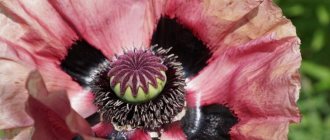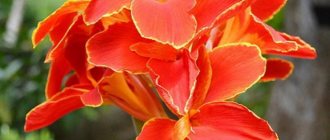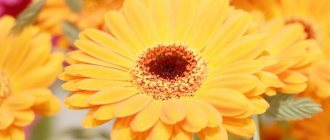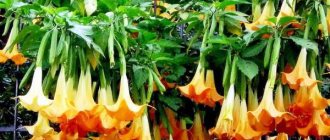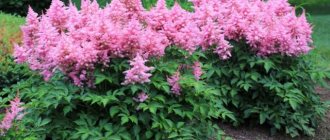Description of Dichondra Emerald Falls
Dichondra hybrid Emerald Falls is a herbaceous plant whose climbing stems reach 1.5 m in length. The leaves on the vines are small, round in shape, slightly pubescent, and rich emerald green in color. They create a dense head of greenery in the places where they grow. Dichondra emerald waterfall flowers are very small and yellowish in color. Against the general background of the plant, they are hardly noticeable, since they barely reach 3 mm.
Using a plant you can imitate a waterfall
Types of dichondra
With all the variety of dichondra species in nature, gardens, on balconies and apartments, only one species is grown - a waterfall. More specifically, these two varieties!
Emerald Falls
A green variety, the size of its leaves depends entirely on the lighting. Moreover, in partial shade they grow larger. In summer, this dichondra blooms with tiny greenish flowers.
Photo: sadik-i-ogorod.ru
Silver Falls
This is the same gray dichondra with long flowing shoots. Its lashes are longer than those of the Emerald Falls, but at the same time not as lush. The variety is surprisingly unpretentious, but requires bright lighting.
Photo: domashniecvety.ru
Kobeya (50 photos): types, cultivation and proper care
Application in landscape design
Dichondra Emerald Falls is an ampelous and ground cover plant. Most often it is grown in hanging pots. Decorate walls, balconies, arches, terraces, gazebos and other objects. If you plant the plant in open ground, it will spread beautifully along the ground, form a continuous carpet and become an excellent backdrop for bright flowers.
With its help you can shade the veranda, cover an alpine hill or flower bed with greenery. Combines with lobelia, petunia and other decorative specimens. Dichondra Emerald Falls is ideal for creating hedges or garden sculptures.
The plant is successfully used in landscape design when it is necessary to create the illusion of a babbling brook. Dichondra emerald waterfall looks attractive in shady gardens under trees where ordinary herbs cannot grow. In the shade, the leaves of the plant become larger. It can be sown in the patio, between the slabs of walkways.
The branches of the plant grow up to 2 m or more in length
Growing from seeds
The seed method of dichondra propagation is quite long-lasting, since the culture takes a very long time to develop.
It is best to sow flower seeds in seedling containers in the middle or end of February, and the seed material is treated with a growth stimulant before planting.
Humidification is carried out using a spray bottle, which will make it possible to maintain the loose structure of the soil in the seedling containers. Next, the boxes are covered with transparent plastic film or a piece of glass and installed in a warm, well-lit room.
It is important to know: during sowing, the grains must be spread on the surface of the soil and lightly sprinkled with loose soil.
The first shoots should appear approximately a week from the moment of sowing. When growing seedlings, seedlings must be hardened off, acclimating them to natural conditions.
Caring for seedlings consists of periodic watering and fertilizing. As we have already said, the process of growing dichondra using seed material is lengthy. The first true leaves of this crop will appear in about a month from the moment of germination.
The appearance of the first two leaves is associated with the need to pick the flower. At this time, the seedlings are moved into separate containers. After the seedlings have grown stronger, the flowers are transplanted into large flowerpots on the balcony or in open ground.
Features of reproduction
There are 3 options for breeding Emerald Falls dichondra. The simplest is layering. At home, if it grows in a pot, you need to surround the plant with plastic cups filled with soil. Place 3 branches on each homemade pot and press it with stones (marble chips) to the ground. You can use pins or anything else that will help secure the branches in close contact with the ground. Dichondra will germinate very quickly (2 weeks). After this, separate all the young plants from the mother bush.
The second method is propagation by cuttings. It goes according to the following scheme:
- cut off several branches;
- put them in water until roots form;
- transplant into the ground.
The third method is the most difficult - growing by seeds.
Important! The leaves of Emerald Falls dichondra have amazing survival rate - when they come into contact with the ground, they very quickly throw out roots and continue to grow further.
The plant is planted in pots, cache-pots or open ground
How to grow a dichondra bush at home in a pot
When asking the question of how to grow dichondra creeping at home in a pot, first of all, you should take into account that this crop is a tropical guest. If the grower creates the conditions necessary for it, the bush can maintain its splendor and decorative appearance for 5 years. The rules for caring for this plant are quite simple, but they should be applied systematically in practice.
Lighting. Dichondra needs good lighting, but does not tolerate direct rays. With a lack of light, the plant loses its decorative effect, as the leaves lose their silvery tint. The plant will feel most comfortable in diffused light. Dichondra should be illuminated for 12 hours a day. In winter, you will need to use a phytolamp. In summer you can keep the bush outside, but in a place where it will not be burned by direct rays.
Air temperature. The optimal temperature range for this crop is 19 – 26 degrees. During the dormant period, which lasts from November to February, the bush can be removed to a cooler place, but with the condition that the air temperature does not drop below 12 degrees. At lower rates, the plant may die.
Watering. When caring for dichondra while growing it at home, you need to take into account that watering should be regular and plentiful, but the earthen ball should not be over-moistened. You need to wait until the top of the substrate dries, then moisten it. It is better to carry out this work in the evening hours. To prevent water from stagnating, the pot must have holes. In order for the root system to receive oxygen and excess moisture not to accumulate in the soil, a drainage layer must be laid at the bottom of the container before planting. Small pieces of ceramics, charcoal, expanded clay, vermiculite, broken brick and others can be used as drainage material.
Air humidity. A representative of the tropics prefers high air humidity, so in an apartment you need to spray the bush with warm, settled water, wipe the leaves with a damp cloth, or install a device in the room that humidifies the air. Such procedures have a beneficial effect on the condition of the foliage, refreshing it and accelerating growth.
The soil. To grow dichondra in an apartment, you can use universal soil intended for indoor flowers. This plant grows and develops well in neutral and slightly alkaline substrates. Drained loams are perfect for this crop.
Feeding. Fertilizing should be applied throughout the growing season, which lasts from April to September. Fertilizer is added to the soil 2 times a month with an interval of 2 weeks. As a top dressing, a mineral complex is used for decorative deciduous plants with an increased dosage of nitrogen and potassium, which promotes intensive growth of green mass.
Trimming. The crown of an indoor dichondra must be periodically shaped so that it maintains a beautiful shape and looks neat. Elongated shoots are shortened, damaged ones are removed. If you do not prune, the stems can grow up to 200 cm. Using this procedure, you can get a plant of any desired shape. To make the bush full, pinch the shoots after 4 pairs of leaves have formed.
Wintering. In winter, the tropical plant requires special care. In order for the dichondra to receive enough light during the wintering period, it is better to place it in a room with windows facing south, or put it on an insulated loggia. If necessary, so that the plant does not suffer from a lack of light, it will be necessary to use artificial lighting. During the heating season, you will have to spray the leaves daily up to 2 times a day.
Transfer. The plant needs to be replanted as the root system grows. If the roots have already begun to appear from the drainage hole, this indicates that the dichondra has become cramped in the pot and it’s time to change it to a wider one. The container for growing this crop should be quite spacious, wide and deep enough, since its roots are constantly developing and quickly entwine the earthen ball.
To remove the bush from the pot, you need to first moisten the soil, which will make the work easier. Take a good look at the roots and cut off any damaged ones. Before planting in a new container, a drainage layer should be placed on the bottom. Transplantation is carried out using the transshipment method. After planting, you should add more substrate, compact the soil around the bush and water it. For the first week after this procedure, it is better to keep the plant in a shaded place, so it will take root faster and more successfully.
How to care for a dichondra flower after planting at home is shown in a selection of photos where the features of this work are visible:
Growing dichondra seedlings Emerald Falls
Dichondra seeds Emerald Falls are germinated through seedlings, sowing them in March-April. Transplantation to a permanent location is carried out in May, when the threat of spring frosts has passed.
When and how to sow
You need to start early - from the end of January to the beginning of spring. The timing of sowing depends on when the dichondra should turn green according to the gardener’s plans. Place the mixture of earth, sand and perlite in a suitable container. This can be a regular plastic container.
Spread the seeds over the surface of the planting soil. Sprinkle water with Epin (growth stimulant) on top. Lightly sprinkle with a thin layer of earth, but no more than 0.3-0.5 cm. Then moisten again with a spray bottle. Cover the container with a lid and put it in a warm place. Normal room temperature +22+24 degrees will be enough.
Seedling care
After a maximum of a week, the seeds will begin to germinate, soon forming small bushes. They should be placed in separate plastic glasses. Add about 10 granules (a pinch) of “Carbamide” (urea) to each plant. Apply fertilizer to the lower layer of soil so that it does not burn the root system. Water each bush with a mixture of water and growth stimulant. In early to mid-May, you can plant the plant in open ground.
Sow seeds in small plastic containers with standard soil
Transfer
Dichondra silver waterfall growing at home photo
The flower is often grown as a houseplant. Caring for this beauty is simple: timely, regular watering (without excess) and sufficient lighting. The air temperature in the room is quite comfortable for the plant; you should not allow it to drop below 10 °C. There are no special requirements for air humidity. The plant responds well to feeding in the spring and summer with a frequency of 1-2 times a month.
It perfectly tolerates proximity to other flowers, which is used to create spectacular compositions. Dichondra is usually planted along the edge of a voluminous pot, creating a cascading waterfall of leaves that shades decorative flowering plants.
Over time, the space for the dichondra becomes small, and it becomes necessary to transplant it into a larger container. If necessary, the flower is replanted using the transshipment method - when the roots tightly entwine the earthen lump in the pot. The signal for this operation is the appearance of roots from the drainage holes of the flowerpot. To do this, select a larger container, on the bottom of which expanded clay is placed, sprinkling it with a small layer of soil on top.
Roots that protrude from the drainage holes are trimmed. With one hand, take the top of the pot and turn it over so that the container is at the top. With the other hand, the flowerpot is removed from the plant like a hat from the head. Then they carefully turn the roots into a new container, pouring fresh soil into the space between the walls of the pot and the roots.
If it is not possible to keep adult plants in an apartment, then many gardeners grow dichondra as an annual, so in the fall they take cuttings, rooting the vines, thereby rejuvenating the flower. Such plantings take up very little space and are much easier to care for.
Dichondra bushes do not lose their attractiveness for 6 years or more with proper, timely care. In Australia and New Zealand, the plant is considered a malicious weed, mercilessly exterminated by farmers and gardeners, but Europeans recognized dichondra as one of the best plants for decorating vertical compositions.
You need to replant the plant to a permanent place in the evening. During the night, the root system adapts to new conditions, which will increase the survival rate of the bush.
Before planting, you need to form holes at a distance of 10 cm from each other. A peat mixture is placed at the bottom of each hole. And only after this, with care, so as not to damage the delicate roots, is the bush planted. The hole is filled with earth and watered well with warm, settled water.
Planting dichondra seedlings
Often grown as an annual. In southern countries and in its historical homeland it grows for several years and is a perennial. In Australia it is considered an ornamental weed with a sanitary role. Usually dichondra is planted in hanging containers.
A green or silver waterfall forms quite easily. Subsequently, you only need to monitor the shape of the “beard” by trimming it regularly. The Silver variety plant is found in independent plantings, as well as in compositions with other flowers.
Shaping a Waterfall Beard
The Repens variety is often used to form green cover on an area. Moreover, if the garden soil has differences in height, then this is beneficial. In this case, the dichondra carpet looks more impressive. The liana looks beautiful in flower beds with helichrysum and when decorating the balconies of houses in combination with flowering plants.
We invite you to familiarize yourself with Currant Viksne: variety characteristics and care
Planting and care in open ground
After small bushes have formed in the planting containers, and the weather is warm in May, you can think about replanting them in flowerpots. Some people immediately place the plant in the flowerbed.
Deadlines
In the spring in May, in the southern territories of the country, the ground, as a rule, warms up well and Emerald Falls dichondra seedlings can be planted in open ground. In the northern regions this happens a little later, in early to mid-June. The degree of seedling readiness also depends on when the seeds were planted.
Site selection and soil preparation
It is better to choose a sunny place for planting Dichondra Emerald Falls, as this plant is light-loving. But it can grow well in light partial shade, and even in the shade. There are also no special requirements for the composition of the soil. It is better suited to drained loamy soil with a pH level of 6.5-8 (slightly acidic, neutral).
Landing algorithm
The soil is loosened and separate holes for bushes are formed every 20-25 cm. Their depth should be sufficient to accommodate the rhizomes of the plant along with the soil from the container. The surrounding soil should not be compacted too much. It will be enough to crush it a little and give it a good watering.
Seedlings are planted in the ground in May-June
Watering and fertilizing schedule
Dichondra Emerald Falls is quite resistant to short-term drought, but watering must be present and be regular. Otherwise, the plant will curl and drop its leaves. It is advisable to do it in the evening - burns will not form on the surface. There is no need to pour excess water to avoid stagnation of liquid in the soil.
Dichondra Emerald Falls during the growing season (April-September) needs regular feeding (once every 15 days). This is an ornamental deciduous plant, so it does not need phosphorus-potassium fertilizers. Preferably nitrogenous fertilizers such as urea should be used.
Weeding
Weeding the Emerald Falls dichondra should be done as often as possible to avoid infecting the plant with pathogenic insects. It's better to do this manually. This is the only way to prevent damage to the stem and nearby roots.
Dichondra Emerald Falls - hanging plant
Trimming and pinching
Dichondra bush Emerald Falls must be formed. To do this, the tips of the branches are pinched, and when the stems grow too much, they are shortened. In warm climates, they can stretch up to 6 m. Mandatory pruning is carried out before the start of wintering.
When the regrown shoots reach the soil, they immediately release rhizomes to take root in it. If this process is not prevented, the Emerald Falls dichondra very quickly forms a dense carpet, completely hiding the area of the ground on which it is located.
The plant can be easily given a decorative shape
Wintering
In the southern regions, where winters are usually warm and mild, the Emerald Falls dichondra can be left in the open ground for the entire cold period. In this case, the plant must be sprinkled with soil on top, and then covered with film and covered with leaves.
In regions where winters are at low temperatures, the plant is dug up and moved to a greenhouse, an insulated loggia, or a balcony. In the spring they are planted again. Cuttings are also taken from the preserved plant (mother plant). They quickly develop their own root system, after which they can be planted in open ground.
Attention! When wintering in an apartment, do not feed the Emerald Falls dichondra; all long strands are cut off.
During the winter, some of the leaves of the plant curl and dry out.
How to preserve silver dichondra in winter
Where winters are cold, dichondra is grown as an annual plant, but it can easily overwinter in a cool room. Before wintering, shoots that are too long are cut off. All care comes down to periodic watering and rare feeding. If possible, it is better to place a flower pot on an entrance window or on a heated loggia - there is enough light there and the temperature is optimal. If you have to keep dichondra in a room, then after turning on the central heating, the leaves need to be sprayed with water several times a day. But most of all it suffers from a lack of lighting - take care of organizing the lighting with special lamps.
You can try keeping the dichondra in the basement. To do this, all shoots are cut off, the rhizome is carefully dug up, and with a lump of earth, it is transferred to the basement and covered with damp peat. In spring, new stems with sprouts form on such a plant. They can be used for cuttings, and the bush itself is planted again in the flowerbed.
Pests and diseases
Dichondra Emerald Falls is very resistant to weeds. In the area where it grows, they hardly grow. The plant has the same high immunity against various pests and diseases.
Despite this, the Emerald Falls dichondra can suffer from nematodes - microscopic worms that grow well in conditions of high humidity. It is impossible to remove them; the plant dies. It is better not to wait until the end, but to get rid of the bush immediately to prevent infection of the rest.
Fleas, aphids and other small insects can settle on the Emerald Falls dichondra. Acaricidal drugs must be used against them. Preventive measures will also help prevent the spread, for example, avoiding mulching and regular hand weeding to remove weeds.
Aphids eat green leaves of a plant
Flower care
The most important point in caring for dichondra is regular watering of the plant. There shouldn’t be a lot of it, but this plant doesn’t like dryness either. The soil should be moderately moist, since this flower is moisture-loving, because in the wild it grows in swampy areas of tropical areas.
The decorative nature of dichondra leaves is what attracts gardeners, landscape designers, florists and just amateurs. And in order for dichondra to achieve the necessary decorativeness of its leaves, it needs to be fertilized and fed from time to time with a variety of complex mineral fertilizers, periodically alternating them with organic ones. Recommended fertilizers: “Ideal”, “Kemira-Lux”, “FETIKA-LUX”, etc.
If you want to form a thick and lush crown, you need to trim regularly. This procedure should also be carried out in preparation for wintering. Dichondra leaves need to be sprayed every day. Such a “shower” will help to significantly accelerate growth and increase leaf mass.
Ampelous dichondra is very resistant to diseases and pests. The only thing that can infect it is a nematode, but there are a large number of ways to combat it. The pests that prevent the plant from growing peacefully are: fleas, aphids and whiteflies.
You only need to remove weeds by hand, so as not to damage the roots that grow shallow in the ground. By caring for and fertilizing the plant correctly and creating all the necessary conditions for it, you can enjoy its appearance for 5-7 years.
Possible problems
Dichondra is undemanding to care . An unpretentious plant copes well with difficulties. It is recommended to regularly spray the stems with special compounds throughout the growing season. This manipulation is justified in relation to pest control. Fleas and nematodes can cause significant damage to the bush, and fighting them will require more effort and time than prevention.
Worth knowing! Adding fluff lime to the soil has worked well. For the same purpose, before planting in the garden, plants are sprayed with a solution of copper sulfate.
Brief description of cultivation
- Bloom . Dichondra is cultivated as an ornamental foliage plant.
- Landing . Seeds for seedlings are sown in January or February, and young plants are planted in open soil from the last days of May to the second half of June.
- Illumination . Grows well in sunny areas, in diffused light, in shady areas and in shade. Varieties with silver foliage are more light-loving.
- Soil . Loams with good drainage and a pH of 6.6–8.0 are ideal for growing crops.
- Watering . Moisten the soil moderately but systematically, and do this in the evening to avoid burns on the leaf blades.
- Air humidity . During the hot, dry period, it is recommended to moisten the foliage in the evening.
- Fertilizer . During the growing season, fertilizing is carried out once every 15 days; for this purpose, complex mineral fertilizer with a high content of potassium and nitrogen is used.
- Trimming and pinching . To make the plant more lush, at the stage of formation of the fourth pair of leaf blades, its stems are pinched. Also, regularly trim the stems every 7 days as they grow.
- Reproduction . By seeds, layering and cuttings.
- Pests . Whiteflies, flea beetles, nematodes and aphids.
- Diseases . It is highly resistant to diseases.
Requirements for place and soil
Usually they try to plant the dichondra in a pot and leave it that way. However, if you want to place it in an open area, try to choose a place that is well protected from drafts. At the same time, do not forget that the emerald dichondra loves partial shade, and the silver one loves the sun. The soil must be well drained; there are no other requirements for it. And note: you need to plant a vine on the site when the temperature has settled within +20 degrees or more. In the southern regions of Russia this happens somewhere in mid-May, in the northern regions - in June. You need to choose a sunny day for planting, without rain.
Watering mode
Given that in the wild the plant actively grows in swamps, it is easier to grow the plant in dry conditions than wet conditions. Settled warm water is used for irrigation. You need to water as needed, constantly keeping the soil slightly moist. The frequency of watering is affected by climate, air temperature, shoot size, planting density, and location.
Dichondra in the exterior
Meet the dichondra flower and its photo!
So, get acquainted, this new guest in the collection will provide a lot of opportunities for phytodesign. The dichondra flower and its photo can be viewed on this page, and tips on growing it from seeds are also given.
It’s worth starting with the fact that the history of the popularization of culture in the country dates back only a decade. For the first time, graceful round leaves forming an unforgettably beautiful living waterfall were presented to amateurs at a specialized exhibition in 2004.
The debut did not go unnoticed - dichondra was awarded medals of the highest standard for originality, unpretentiousness and universal purpose.
But let’s return to the origin of the species, which belongs to the vast family of bindweeds. The first representative of this species was discovered at the end of the eighteenth century in East Asia.
Several decades later, similar plants were brought from America, Africa and Australia. But initially, apparently, no corresponding bet was made.
The grass, unremarkable in its natural growing conditions, did not cause great delight among botanists.
A little later, the attention of florists was attracted by the opportunity to form a soil cover when creating rock gardens. This is how the story of the popularity of an inconspicuous hanging culture began
And today, despite numerous works in the field of selection, dichondra flowers make it possible to form dense flowing waterfalls of emerald or silver-colored vegetation. However, flowers cannot be expected; this is an exclusively deciduous plant.
The branches are distinguished by their grace and amazing length. With proper care, the lashes can hang down 6-8 meters. They are densely covered with small rounded leaves. The foliage color can be bright green or silver, depending on the variety.
A quick set of deciduous mass allows you to create an imitation of a waterfall or a running green stream on your garden plot in a matter of weeks.
There are many ways to use this representative of the flora. In the photo, the ampelous dichondra is presented in various types of practical applications:

